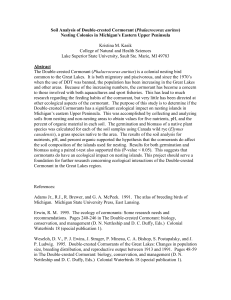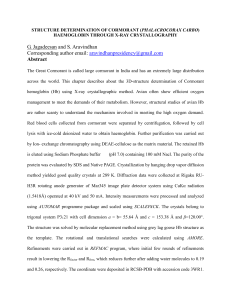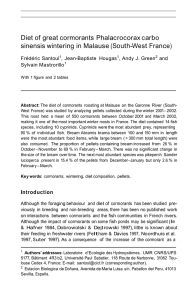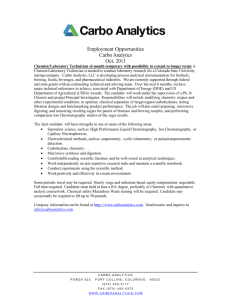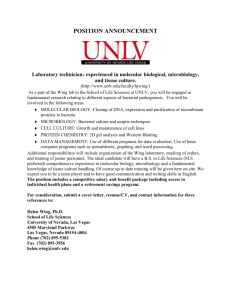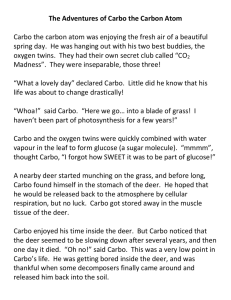doc-file
advertisement
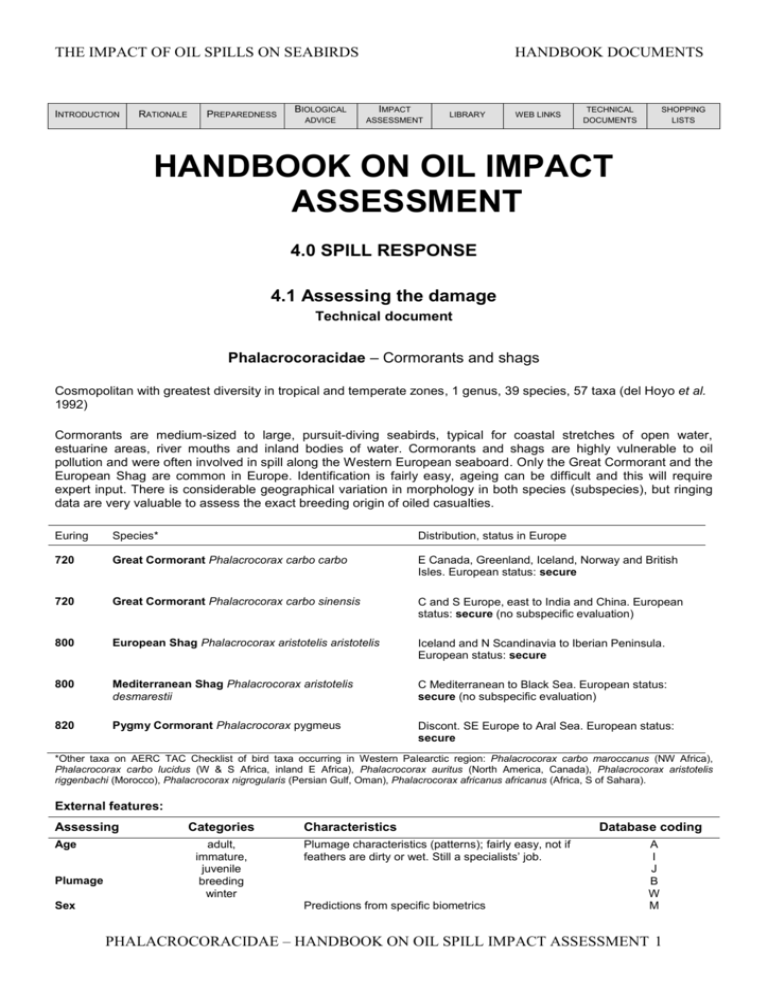
THE IMPACT OF OIL SPILLS ON SEABIRDS INTRODUCTION RATIONALE PREPAREDNESS BIOLOGICAL ADVICE HANDBOOK DOCUMENTS IMPACT ASSESSMENT LIBRARY WEB LINKS TECHNICAL DOCUMENTS SHOPPING LISTS HANDBOOK ON OIL IMPACT ASSESSMENT 4.0 SPILL RESPONSE 4.1 Assessing the damage Technical document Phalacrocoracidae – Cormorants and shags Cosmopolitan with greatest diversity in tropical and temperate zones, 1 genus, 39 species, 57 taxa (del Hoyo et al. 1992) Cormorants are medium-sized to large, pursuit-diving seabirds, typical for coastal stretches of open water, estuarine areas, river mouths and inland bodies of water. Cormorants and shags are highly vulnerable to oil pollution and were often involved in spill along the Western European seaboard. Only the Great Cormorant and the European Shag are common in Europe. Identification is fairly easy, ageing can be difficult and this will require expert input. There is considerable geographical variation in morphology in both species (subspecies), but ringing data are very valuable to assess the exact breeding origin of oiled casualties. Euring Species* Distribution, status in Europe 720 Great Cormorant Phalacrocorax carbo carbo E Canada, Greenland, Iceland, Norway and British Isles. European status: secure 720 Great Cormorant Phalacrocorax carbo sinensis C and S Europe, east to India and China. European status: secure (no subspecific evaluation) 800 European Shag Phalacrocorax aristotelis aristotelis Iceland and N Scandinavia to Iberian Peninsula. European status: secure 800 Mediterranean Shag Phalacrocorax aristotelis desmarestii C Mediterranean to Black Sea. European status: secure (no subspecific evaluation) 820 Pygmy Cormorant Phalacrocorax pygmeus Discont. SE Europe to Aral Sea. European status: secure *Other taxa on AERC TAC Checklist of bird taxa occurring in Western Palearctic region: Phalacrocorax carbo maroccanus (NW Africa), Phalacrocorax carbo lucidus (W & S Africa, inland E Africa), Phalacrocorax auritus (North America, Canada), Phalacrocorax aristotelis riggenbachi (Morocco), Phalacrocorax nigrogularis (Persian Gulf, Oman), Phalacrocorax africanus africanus (Africa, S of Sahara). External features: Assessing Age Plumage Sex Categories adult, immature, juvenile breeding winter Characteristics Plumage characteristics (patterns); fairly easy, not if feathers are dirty or wet. Still a specialists’ job. Predictions from specific biometrics Database coding A I J B W M PHALACROCORACIDAE – HANDBOOK ON OIL SPILL IMPACT ASSESSMENT 1 THE IMPACT OF OIL SPILLS ON SEABIRDS Assessing Categories HANDBOOK DOCUMENTS Characteristics Database coding F Colour phase Biometrics Priority Bill length 1 Bill tip to feathers (0.1 mm) Bill length 2 Bill tip to nostril (0.1 mm) Bill depth 1 Bill depth at base (0.1 mm) Bill depth 2 Bill depth at gonys (0.1 mm) Bill depth minimum Bill depth just posterior of gonys (0.1 mm) Head length (mm) Wing length (mm) Tarsus length (mm) Bill tf – Bill base – Bill min – Head – Wing – Tarsus Structure Primaries P.c. carbo P.c. sinensis P. aristotelis P. pygmeus 10 + 1m 10 + 1m 10 + 1m 10 + 1m Longest Primary P9/P8 P9/P8 P9/P8 P8 (P8) Tail feathers 14 14 12 12 Bill tf Bill tn Bill base Bill gonys Bill min Head Wing Tarsus Shape of tail rounded rounded rounded wedge, long General characteristics (from BWPi 2006): Medium-sized to large aquatic birds. Body elongated, neck rather long. ♂ larger than ♀. Wings with long inner portion and short tip. 11 primaries, p8 and p9 longest; 17–23 secondaries. Tail long and strongly wedge-shaped, 12–14 pointed feathers. Bill strong, of medium length, laterally compressed, culmen rounded; hooked at tip; nostrils closed. Gular skin bare. Tarsus heavy; toes long, outer longest, nail of middle toe medially with comb. Tibia feathered. Legs set far back. Plumage black, often with metallic sheen. Sexes similar. Breeding plumage different from non-breeding, often by increase of white filoplumes. 2 moults per cycle, pre-breeding involving relatively few feathers; primaries replaced in serially descendant order. Juveniles differ from adult by being duller or paler; reach adult plumage in 3rd-4th calendar year. Basic biometrics (summarised) Species sex Bill tf Bill min Wing Tarsus Phalacrocorax carbo carbo ♂ ♀ 66-86 59-77 16-18 13-15 330-370 318-365 67-82 Phal. carbo sinensis ♂ ♀ 55-75 50-72 13-16 11-13 323-382 310-360 63-78 62-71 Phalacrocorax aristotelis ♂ ♀ 50-71 57-69 9.3-14.2 7.6-12.5 263-289 252-281 62-70 58-65 Phalacrocorax pygmeus ♂ ♀ 29-33 27-31 195-217 193-208 37-40 36-39 Geographical variation Great Cormorant (from BWPi 2006): Three races recognized in west Palearctic. P. c. sinensis (most of Europe) smaller than nominate carbo (Atlantic coast), especially bill; plumage glossed blue-green rather than blue-purple, but variable and some carbo have green-glossed chest, some west European sinensis slight purple gloss. P. c. sinensis has more white plumes on head and neck, but number dependent on age, and, rarely, old carbo have as many as typical sinensis. P. c. maroccanus (North Africa) intermediate between sinensis and tropical African race lucidus: throat and upper chest white. Shag (from BWPi 2006): Slight in north-west Europe; see Measurements. Mediterranean subspecies P. a desmarestii slightly smaller than nominate aristotelis, but bill longer and more slender; bare skin at base of lower mandible in adult more extensive, paler yellow; bill usually yellow except black culmen and tip; foot brown with yellow webs; crest on average shorter, sometimes absent. Juvenile with much white on underparts; throat, breast, and belly at least white, sometimes chin to under tail-coverts (but not flanks). North-west African P. a. riggenbachi combines body size and colour of bare parts of P. a. desmarestii with bill dimensions of nominate aristotelis (Hartert 1921). PHALACROCORACIDAE – HANDBOOK ON OIL SPILL IMPACT ASSESSMENT 2 THE IMPACT OF OIL SPILLS ON SEABIRDS HANDBOOK DOCUMENTS Figure 1. Key measurements in cormorants and shags: bill length tip to feathers (Bill tf; A-B) and minimum bill depth, just behind the gonys (Bill min; x-y). From Camphuysen 1998. Minimum bill depth is used to predict sex ratios (Calvo & Bolton 1997) and for species identification. Ratio bill tf / bill min (i.e. A-B / x-y) Great Cormorant European Shag ± 4.5 ± 5.5 Identification assistance: Great Cormorants versus European Shags Both species are large, blackish waterbirds with a long neck, a long tail, a hooked bill and rounded wing tips. Adults are almost entirely black (green metallic, blue metallic or purple metallic gloss in fresh and clean specimens). A diagnostic difference between cormorants and shags is the wing length: >310 mm in cormorants and <280 mm in shags. The bare gular skin is more extensive in cormorants than in shags (Figs. 2-3) and the bill in cormorants is heavier. Finally, cormorants have 14 tail feathers, shags only 12 (do check for completeness). Figure 2. Head patterns of juvenile and adult (breeding) Great Cormorants. Note the more extensive bare gular skin area in cormorants than in shags (Fig. 3). From Camphuysen 1998. Figure 3. Leg (left) and head patterns (right) of juvenile and adult (breeding) Eurpean Shags. Note the less extensive bare gular skin area in cormorants than in cormorants (Fig. 2). In stranded specimens, crest feathers are normally not very obvious, and crests are only a prominent feature in the early breeding season. From Camphuysen 1998. PHALACROCORACIDAE – HANDBOOK ON OIL SPILL IMPACT ASSESSMENT 3 THE IMPACT OF OIL SPILLS ON SEABIRDS HANDBOOK DOCUMENTS Ageing Great Cormorants and European Shags Figure 4. Tips of secondaries (A) and primaries (B) in juvenile and adult cormorants. Blunt or rounded in adults, sharply pointed or sharp tipped in juveniles. Secondaries and primaries of juvenile cormorants are pointed, or have a sharp tip (Fig. 4), whereas primaries and secondaries of mature birds are generally rounded and worn. Primaries are replaced in serially descendant order, similar as in Northern Gannets, and an active moult centre can be seen in mature birds or immatures >1cy of age. The presence of wing moult points at a non-juvenile bird. Figure 5. Variability in pattern of underparts in Great Cormorants (Camphuysen 1998). See also Bauer & Glutz von Blotzheim (1966). Juveniles and immatures do not have fully black underparts. In juvenile Great Cormorants, the underparts are largely or partly whitish (but highly variable; Fig. 5). Underparts of juvenile European Shags are light brown to nearly whitish (darker evenly brown in immature birds). Both species have a fine scaled appearance of mantle and upperwing, but the feathers of juveniles and adults are very different. Immature birds (non-juveniles) are likely to have a mix of adult and juvenile feathers, and a less shining metallic gloss of so-called ‘adult’ countour feathers. Phalacrocorax aristotelis Figure 6. Mantle feathers and upperwing coverts of European Shag and Great Cormorant (after Camphuysen 1998). metallic green brown dark brown black blackish whitish whitish juvenile fresh juvenile worn adult breeding Phalacrocorax carbo metallic bronze dark brown blackish black whitish juvenile fresh adult breeding Juvenile European Shags have whitish fringes on these feathers with a dark subterminal band. Worn feathers have even broader whitish fringes, but the subterminal band is vague or even absent. Adult birds have green glossy feathers with clearcut black edges, giving the characteristic scaled appearance. The feather tips are V-shaped rather than rounded. In juvenile Great Cormorants, the whitish tip of these feathers is narrow, easily wears off, leaving a rather wide brown terminal band over dark brown feathers. Adult birds have mostly rounded mantle feathers with a broad black band and a metallic bronze centre. PHALACROCORACIDAE – HANDBOOK ON OIL SPILL IMPACT ASSESSMENT 4 THE IMPACT OF OIL SPILLS ON SEABIRDS HANDBOOK DOCUMENTS Sexing European Shags Phalacrocorax aristotelis External measurements can be used to predict the sex of adult European Shags, as could be demonstrated with discriminant analysis by Calvo & Bolton (1997) from Shetland material, colleted during the Braer oil spill in 1993. Key measurements are wing length (Wing) and minimum bill depth (Bill min). Based on a combination of measurements, over 95% of females would be properly identified, whereas 91% of males were sexed correctly, using discriminant scores (D, where D < 0 ♀♀ and D > 0 ♂♂): D = (1.421 x Bill min) + (0.095 x Wing) – 39.647 (♀ 96.4% correct, ♂ 91.3% correct) From single measurements, especially from bill depth (Bill min), the predictions were still often correct: D = (1.796 x Bill min) – 17.925 (♂♀ 92.8% correct) D = (0.201 x Wing) – 53.978 (♂♀ 85.1% correct) Sexing Great Cormorants Phalacrocorax carbo sinensis Koffijberg & Van Eerden (1995) obtained a sample of 116 Great Cormorants consisting birds which had drowned in gill nets and fykes in the IJsselmeer (The Netherlands). Discriminant analysis applied on total body length (L), wing length (wing), sternum length (sternum), bill length (bill tf), and bill depth (bill base) separately showed that 71.4% and 87.4% (adults and immatures combined) could be sexed accurately. Bill depth was the best single parameter allowing for segragation between males and females: D = 0.71 x (bill base) – 14.35 (♂♀ 87.4% correct) A slightly lower classification rate was calculated when using wing length (wing): D = 0.09 x (wing) – 31.63 and all individuals with a wing length >336.6 mm could safely be assumed being males. The best prediction (96.1% correct overall ) was made by a combination of measurements, including total body length (L), wing length (wing), and bill depth (bill base). D = 0.09 (L) + 0.06 (wing) + 0.44 (bill base) – 35.53 (♂ 100% correct, ♀ 92% correct) It should be noted that using sternum length to predict sex is useful only in case of scavenged carcasses, with gonads being eaten away. Sternum length can be measured only during a standard autopsy, and it is more direct and accurate to assess the sex and age from internal inspection rather than from sternum length. References Bauer K.M. & Glutz von Blotzheim U.N. 1966. Handbuch der Vögel Mitteleuropas, 1. Akad. Verl., Wiesbaden. Calvo B. & Bolton M. 1997. Sexing shags Phalacrocorax aristotelis from external measurements using discriminant analysis. Ringing & Migration 18(1): 50-56. Camphuysen C.J. 1998. De herkenning van Aalscholver Phalacrocorax carbo en Kuifaalscholver Strictocarbo aristotelis in de hand. Sula 12(2): 73-80. [The identification of Great Cormorants and European Shags in the hand In Dutch] Hartert E. 1921. Der Vögel der paläarktischen Fauna, Bd. II und Erganzungsband. R. Friedlander. and Sohn, Berlin. Koffijberg K. & Eerden M.R. van 1995. Sexual dimorphism in the Cormorant Phalacrocorax carbo sinensis: possible implications for differences in structural size. Ardea 83: 37-46. Macdonald J.W. 1962. Mortality in wild birds with some observations on weights. Bird Study 9: 147-167. Velando A., J. Graves & J. Freire 2000. Sex-specific growth in the European Shag Stictocarbo aristotelis, a sexually dimorphic seabird. Ardea 88(2): 127-136. Wanless S. & Harris M.P. 1997. Phalacrocorax aristotelis Shag. BWP Update 1(1): 3-13. PHALACROCORACIDAE – HANDBOOK ON OIL SPILL IMPACT ASSESSMENT 5 THE IMPACT OF OIL SPILLS ON SEABIRDS HANDBOOK DOCUMENTS Citation Camphuysen C.J.1 2007. Phalacrocoracidae: Cormorants and shags. Technical documents 4.1, Handbook on Oil Impact Assessment, version 1.0. Online edition, www.oiledwildlife.eu Contact address 1 C.J. Camphuysen, Royal Netherlands Institute for Sea Research, P.O. Box 59, 1790 AB Den Burg, Texel, The Netherlands, camphuys@nioz.nl Read and commented by: PHALACROCORACIDAE – HANDBOOK ON OIL SPILL IMPACT ASSESSMENT 6
